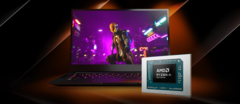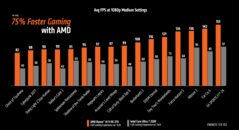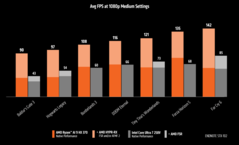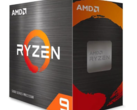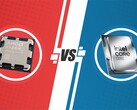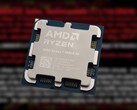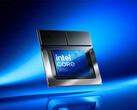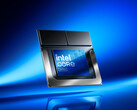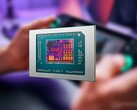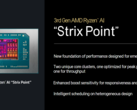Now that the AMD Ryzen AI 9 HX 370 and Intel Core Ultra 7 258V have been around a while, AMD has taken the opportunity to compare its Strix Point offerings with its Lunar Lake competitor. This comparison focuses on gaming performance, and AMD's first party data (unsurprisingly) says it is ahead of Intel. The following graphs illustrate how Strix Point fares in some popular titles at 1080p.
AMD tested the Ryzen AI 9 HX 370 in sixteen games, where they outperformed the Core Ultra 7 258V by 75% on average. The Strix Point system was an Asus ZenBook S16 with 32 GB LPDDR5-7500 RAM, whereas the Lunar Lake silicon was tested alongside an Asus ZenBook S14 with the same amount of memory.
A closer look at the graphs reveals both chips output more or less the same frames natively. The Radeon 890M gets an advantage due to AMD FSR 3.0 and AFMF frame generation. While Intel XeSS does deliver a measurable uplift in performance, it still lags behind the competition; the lack of availability isn't doing it any favours either.
| Asus Zenbook S 16 UM5606-RK333W Radeon 890M, Ryzen AI 9 HX 370, Micron 2400 MTFDKBA1T0QFM | Asus Zenbook S 14 UX5406 Arc 140V, Core Ultra 7 258V, WD PC SN560 SDDPNQE-1T00 | |
|---|---|---|
| Ghost of Tsushima | ||
| 1920x1080 Medium Preset AA:T (fps) | 28 | 28.7 |
| Cyberpunk 2077 2.2 Phantom Liberty | ||
| 1920x1080 Medium Preset (FSR off) (fps) | 31.3 | 31.7 |
| Baldur's Gate 3 | ||
| 1920x1080 Medium Preset AA:T (fps) | 35.8 | 26.3 |
| F1 23 | ||
| 1920x1080 Medium Preset AA:T AF:16x (fps) | 69.3 | 78 |
| Final Fantasy XV Benchmark | ||
| 1920x1080 Standard Quality (fps) | 38.3 | 40.9 |
| Strange Brigade | ||
| 1920x1080 medium AA:medium AF:4 (fps) | 71.1 | 77.4 |
| Dota 2 Reborn | ||
| 1366x768 med (1/3) (fps) | 123.1 | 59.7 |
| Total Average (Program / Settings) |
Our benchmarks arrive at the same conclusion: AMD requires FSR and AFMF to maintain a competitive advantage against Intel. It largely comes down to the title in numerous instances.
However, that isn't a bad thing because these technologies are made to extract maximum performance out of low-power chips; they're clearly working as intended, and it'll be interesting to see how AMD takes them forward with RDNA 4.
Source(s)
AMD




